Over the past few years, I’ve been camping and hiking both in my home state of Colorado and abroad, and my packing list for these excursions includes a few absolute essentials that ensure my safety while I’m out in the wilderness. One of my hiking must-haves is a portable water purifier, and the Grayl UltraPress has accompanied us on some of my most recent trips in Colorado, Mexico, and Guatemala.
I tested the Grayl UltraPress’s ease of use, ability to improve my water quality, reliability, and more. In this Grayl water filter review, I’ve shared what I thought about all aspects of its performance.
Table of Contents
🧾 Overview of the Grayl UltraPress
The Grayl UltraPress is a push water purification bottle that removes 99.99% of viruses, bacteria, and protozoa, turning untreated water into clean, drinkable water with zero setup required.
The bottle uses Grayl’s OnePress technology to filter water. The idea is that you fill the bottle with dirty water, then press the lid and filter attachment down into the bottle until the lid meets with the bottle mouth. As you press, the water gets filtered, which means once you’ve pressed the lid all the way down, your water is ready to drink.
This unique approach to water filtration means that the UltraPress is easier to use than other water filter bottles. It doesn’t have a straw filter, so there’s no sipping forcefully through a straw, and because it actually filters water, it removes particulates as well as microorganisms.
Grayl offers a 10-year warranty covering workmanship and materials for the UltraPress, so I had the reassurance of knowing I was covered if anything ever became faulty or broken outside of normal wear and tear. The purifier also comes with an industry-leading 1 year guarantee, so if I decided I didn’t love it within the first year, I could send it back for a full refund.
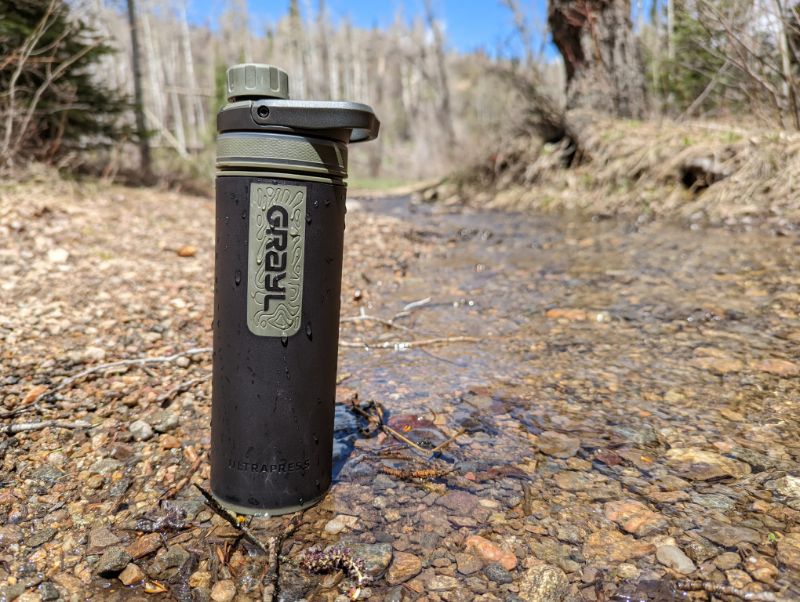
In my testing, the Grayl UltraPress stood out for being compact, sturdy, and attractive to look at. I noted that it gave me an absurdly easy way to get clean, safe, and actually good-tasting water from almost any fresh water source. However, I do think the UltraPress is a bit expensive for what you get, and because of its weight and water-holding capacity limitations, I wouldn’t put it as my first choice for extended hiking trips, camping, or emergency preparation.
👍 What I Like
- Super easy press filtration (no difficult-to-use filter straw or pump)
- Eliminates the need for plastic water bottles
- Targets bacteria and viruses
- Attractive bottle design
- Provides quick filtration – no waiting for gravity
- Carbon filter component improves taste of water & removes additional dangerous contaminants
👎 What I Don’t Like
- 40-gallon filter lifespan is poor
- No way to backwash the filter to extend its lifespan
- Water holding capacity is quite small
- One of the heavier water bottle filters I’ve tested
💡 First Impressions
My first impression of the Grayl UltraPress was related to price. It costs $90, so it’s definitely not a cheap filtered water bottle. That said, the price hasn’t increased in at least a year – it’s the same as when I first reviewed it in October 2022.
The package I received contained the following items:
- The UltraPress bottle (I could choose between several neutral shades and camouflage colors)
- The inner press
- The bottle lid/drink cap
- Our first purifier cartridge
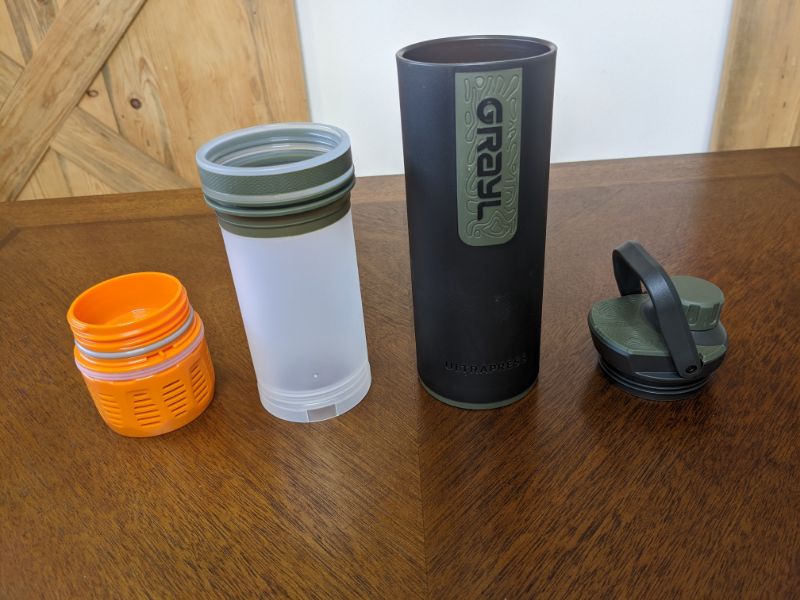
The bottle is made from food-grade silicone, BPA-free plastic, and thermoplastic polymer. It’s quite heavy, weighing 12.5 ounces when it’s empty. But while it does have weight, it’s not as big or bulky as some of the other filtered water bottles I’ve tested. This has pros and cons: the bottle’s compact and slim size means it fits in most backpack pockets and cup holders, but it only holds 16.9 ounces (or around 0.5 liters) of water. That meant I’d have to refill it more regularly, even when using it as a personal filtration solution.
Getting started was pretty simple – I just had to assemble the bottle, and then I could use it straight away. I didn’t have to prime the filter, and there were no small or fiddly components that I’d need to attach and detach every time. I could assemble the bottle at home, which meant I didn’t have to waste time doing this while I was out hiking.
I noted a few handy design features that made the press filtration process easier. The top of the bottle lid is slightly padded, which made pressing the bottle more comfortable and meant there was no risk of my hands slipping off the top. There’s also a flip carry handle that makes it easy to pull the inner press from the outer cup, and some nice non-slip rubber on the bottom and sides of the bottle, making it easier to grip. Keeping the spout cap on between uses prevents cross-contamination.
In all, on first inspection and use, I thought the Grayl UltraPress was thoughtfully and ergonomically designed, albeit heavier and restricted by a smaller water holding capacity, which could make it unsuitable for some folks.
📝 System Specifications
| Capacity | 500 ml |
| Weight | 354 grams |
| Height | 9.75 inches |
| Base diameter | 2.95 inches |
| Filter technology | Ultra-powdered activated carbon, ion exchange |
| Flow Rate | 3 liters per minute |
| Filter Lifespan | 300 presses |
| Filter Shelf Life | 3 years |
| Materials | Food-grade silicone, BPA-free polypropylene, food-grade plastic |
🧪 My Testing
I’ve taken the Grayl UltraPress on my hiking trips all over, including to various trails in Colorado, as well as abroad to Mexico and Guatemala. I’ve used the filter on lake water and river water, and while I always aim to choose the cleanest water source, I did filter a few turbid water sources, too. After all, you can’t always be choosy when you’re out in the sticks!
I wanted to test the UltraPress for a few specific performance factors, including how it improved my water quality, how easy it was to use, and how long it took to treat my water.
I’ve discussed these factors in detail in the below sections.
My Water Quality
The Grayl UltraPress contains an ultra powdered activated carbon filter. Most water bottles that use carbon filters can’t remove tiny contaminants like viruses, but powdered activated carbon has delivered excellent results for bacteria and virus removal in tests (see this study).
According to Grayl, the purification cartridge used in the UltraPress can remove more than 99.9% of waterborne pathogens like bacteria, viruses, and protozoa, as well as particulates, chemicals, and heavy metals.
That made it more appealing to me compared to the UV water bottle purifiers I’ve tested, which can only kill microorganisms and don’t make a noticeable difference to water quality.
Activated carbon is the most popular water filter media used for improving the taste and odor of water. It’s favored for its ability to remove chlorine, found mostly in city water supplies. I’ve used the bottle once or twice to filter my municipal water in Colorado, and I found that my water tasted cleaner and with no chemical aftertaste or odor after it had been filtered.
The UltraPress also did a good job of making my river and lake water taste palatable. I’ve tested a fair few survival filters that don’t make much of a difference to water taste, meaning I’d have to force myself to drink filtered water with a distinguishable musty, earthy taste and odor.
The Grayl UltraPress ticked two of my boxes in one: it reassured us that the water I was drinking was safe, and removed the most unpleasant tastes and odors.
The fact that the UltraPress can remove viruses was also a big bonus for me, meaning that I could use the bottle to filter water supplies overseas without the risk of getting sick. Viruses aren’t an issue in natural water sources in the U.S., but they are sometimes found in dirty water sources elsewhere in the world.
I haven’t yet had the chance do my own water test to see what the UltraPress could remove, but I have plans to do this soon, and I’ll share my results in this review once I have.
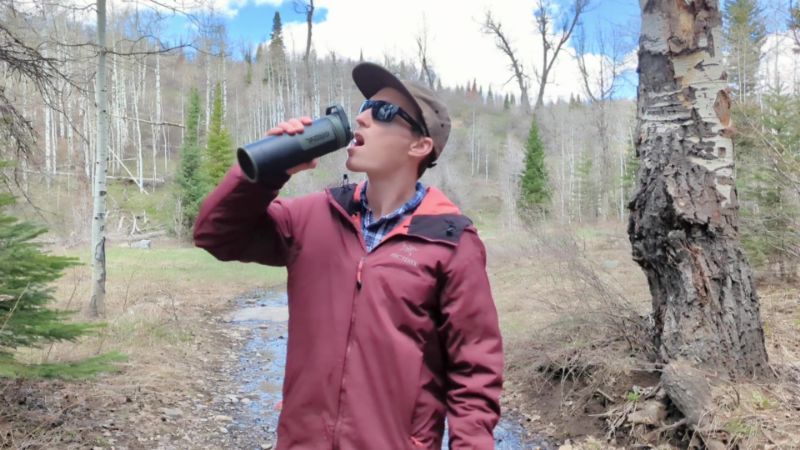
👌 Ease of Use
I also wanted to test how easy it was to use the UltraPress to filter water on my hiking trips. Ease of use is an important performance feature for me because I want to feel confident in my ability to make my water safe to drink.
There are two parts to the Grayl purifier bottle: the actual bottle, and a separate piece (the lid) that houses the push filter.
Compared to some other hiking water purifiers, I found the UltraPress super easy to use. I didn’t have to do any sort of manual assembly mid-hike, or wait several minutes for the filtration process to take place.
I just filled the bottle with water and pushed the filter into the bottle. This created a plunging effect that forced the water through the filter. At this point, I twisted the cap at the top of the lid to vent air during the filtration process.
How much force did I have to use? Quite a bit – I had to use my upper body weight and lean forward on the lid to send the inner press downward towards the floor.
It was also essential that I placed the bottle on a flat surface while I was doing this – I once tried on an uneven surface and my center of gravity was off, so I ended up slipping.
As I mentioned earlier, there are a few design features that make it easier to use, including the ergonomic, padded push lid for comfortable pressing, the vented bottle cap, which I could open to release pressure while I was pressing, and the wide drinking spout, which was easy to drink from.
Once I’d pressed the inner press all the way down, I could drink my water (the easy part!). I could either drink straight from the nozzle on the bottle or pour the filtered water into my backpack’s hydration bladder, then go again.
In all, using the UltraPress is a bit of a workout, but only during the pressing stage, which doesn’t last long.
I’d personally prefer to filter an entire bottle’s worth of water in one press, rather than gradually filter water every time I sip on a straw, which is more annoying. If you’re fit and healthy enough to be hiking, you won’t have any issues with the press function. You don’t have to be Hercules by any means!
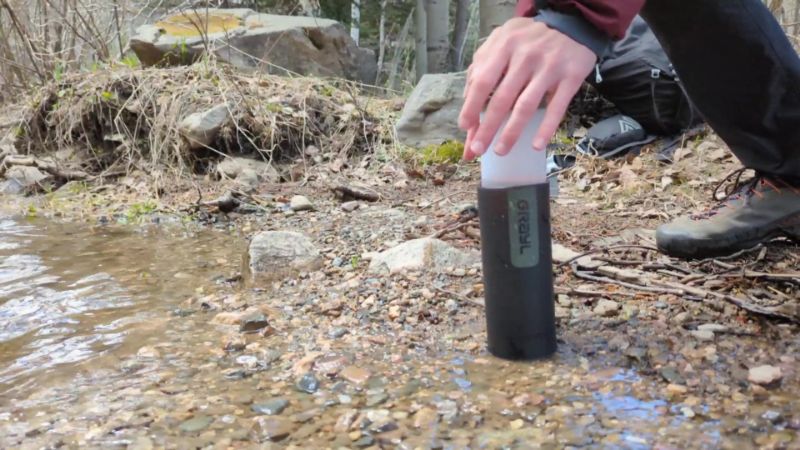
Treatment Time
One of the things I loved most about the Grayl UltraPress was how fast it was to filter my water.
I personally prefer bottle water filters like the UltraPress compared to gravity filters, which filter water at a slow and steady pace, requiring you to wait around until you’re done.
It took me less than 10 seconds to filter a full bottle of water, which comes out to be a flow rate of about 3 liters per minute. The exact pressing time depends on two key factors:
- How much force you exert on the bottle. The more weight you can use when pressing down, the faster the inner press will glide into the bottle.
- Source water quality. The quality of the water I was purifying also affected the treatment time. The more turbid and sediment-rich the water, the more resistance there was when I pressed, which typically meant it took me slightly longer to send all the water through the filter.
I appreciated having instant access to purified water whenever I was in need of a drink. Given that the bottle doesn’t need to be assembled before every use, I could simply take it straight out of my backpack, then fill it with water and filter it instantly.
I could then carry the bottle with me and drink at intervals, rather than having to drink a whole load of water at the source, then have nothing until I came across the next lake or stream.
One thing I did note is that while the treatment time is fast, there were some limitations with the smaller water capacity.
The bottle only holds around 0.5 liters of water at a time, so I wouldn’t recommend it for large groups or camping situations where a lot of water is needed for cooking, cleaning, drinking, and so on. It’s best used as a personal solution, or for two people, maximum.
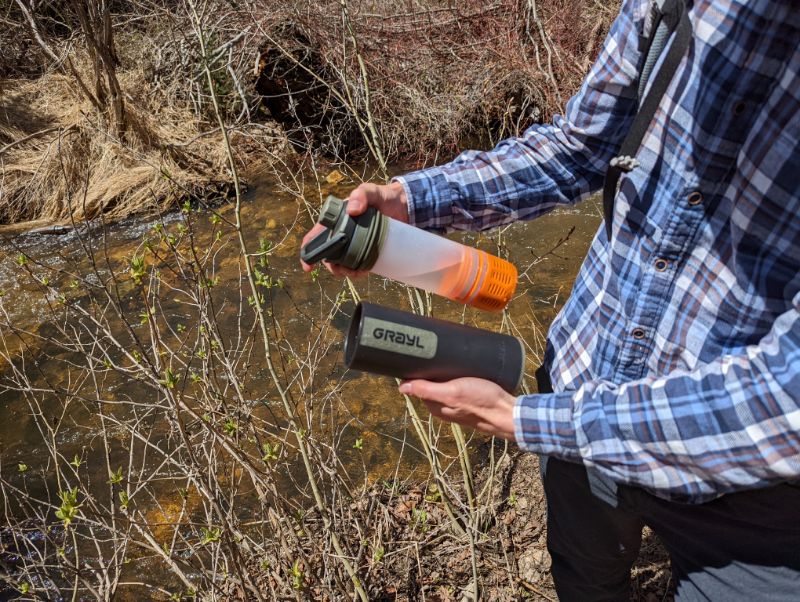
📑 Filter Testing & Certifications
The purifier filter cartridge used in the Grayl UltraPress combines electroadsorptive activated carbon and ion exchange media, and has been independently tested by a certified lab to meet, or exceed NSF standards 42 and 53 for its ability to remove sediment, pathogens and chemicals.
Grayl has shared test results for the GeoPress, which uses the same filter as the UltraPress – just slightly larger. Some of the key contaminants the GeoPress has been tested to remove are:
- Up to 99.9999% raoultella terrigena (a bacterium)
- Up to 99.998 MS2 coliphage (a type of virus)
- Up to 99.998% protozoan cysts (tested on cysts with a 3.0-micron microsphere)
The GeoPress has also been tested to remove the following physical particulates and contaminants:
- 97.8% Particulates Class I
- Heavy metals, including up to 93% arsenic, 99.5% chromium, and 99.6% lead
- Volatiles, including up to 97.37% benzene, 87.50% chloroform, and 75% vinyl chloride
Plus, the filter meets the EPA Guide Standard and Protocol for testing microbiological water purifiers, which is good proof that it’ll perform as advertised and keep you from getting sick.
You can view Grayl’s test report here.
I’m definitely reassured by the manufacturer’s testing, but for me, the cherry on top would be an official performance certification, especially for pathogen removal. That would give me the extra reassurance of approval from a trusted official testing organization.
View the full list of contaminants removed from the UltraPress Grayl water bottle filter in the table below.
| Contaminant | Percent Removal |
|---|---|
| Bacteria (Raoultella terrigena) | >99.9999% |
| Virus (MS2 Coliphage) | 99.998% |
| Protozoan cyst (3.0um Microsphere) | >99.998% |
| Microplastics (5-1000 Micron) | 99.99% |
| Class I particles (0.5 - <1.0 micron) | 97.8% |
| Parasites (3.0um Microspheres) | 99.995% |
| Arsenic | 93.00% |
| Cadmium | >99.8% |
| Chromium | >99.5% |
| Copper | 40.82% |
| Lead | >99.6% |
| Silver | 75.67% |
| 1,1,1,2-Tetrachloroethane | 96.30% |
| 1,1,1-Trichloroethane | 91.52% |
| 1,1,2,2-Tetrachloroethane | 95.71% |
| 1,1,2-Trichloroethane | 94.26% |
| 1,1-Dichloroethane | 83.23% |
| 1,1-Dichloroethene | 92.35% |
| 1,1-Dichloropropene | 94.88% |
| 1,2,3-Trichlorobenzene | >99.11% |
| 1,2,3-Trichloropropane | 95.98% |
| 1,2,4-Trichlorobenzene | >99.0% |
| 1,2,4-Trimethylbenzene | >98.1 |
| 1,2-Dibromo-3-Chloropropane | 97.67% |
| 1,2-Dichlorobenzene | >99.5% |
| 1,2-Dichloroethane | 86.19% |
| 1,2-Dichloropropane | 93.51% |
| 1,3,5-Trimethylbenzene | 97.46% |
| 1,3-Dichlorobenzene | >99.2% |
| 1,3-Dichloropropane | 95.71% |
| 1,4-Dichlorobenzene | >99.3% |
| 2,2-Dichloropropane | 90.00% |
| 2-Butanone (MEK) | 49.71% |
| 2-Chlorotoluene | 98.27% |
| 2-Hexanone | >75% |
| 4-Chlorotoluene | >99% |
| 4-Isopropyltoluene | >98.3% |
| 4-Methyl-2-pentanone (MIBK) | >75% |
| Benzene | 97.37% |
| Bromobenzene | >99.2% |
| Bromoform | 95.07% |
| Bromomethane | >74% |
| Carbon disulfide | >75% |
| Carbon tetrachloride | 93.95% |
| Chlorobenzene | >98.5 |
| Chlorobromomethane | 78.70% |
| Chlorodibromomethane | 95.69% |
| Chloroethane | >74% |
| Chloroform | 87.50% |
| Chloromethane | >75% |
| cis-1,2-Dichloroethene | 92.88% |
| cis-1,3-Dichloropropene | 95.81% |
| Dibromomethane | 87.50% |
| Dichlorobromomethane | 92.92% |
| Dichlorodifluoromethane | >74% |
| Ethylbenzene | 97.87% |
| Ethylene Dibromide | 96.49% |
| Hexachlorobutadiene | >99% |
| Isopropylbenzene | 96.03% |
| Methyl tert-butyl ether | >75% |
| Methylene Chloride | 60.23% |
| m-Xylene & p-Xylene | 98.87% |
| Naphthalene | >98% |
| n-Butylbenzene | >97.7% |
| N-Propylbenzene | >98.1% |
| o-Xylene | 97.95% |
| sec-Butylbenzene | >98.2% |
| Styrene | 98.64% |
| tert-Butylbenzene | >97% |
| Tetrachloroethene | 98.63% |
| Toluene | 98.64% |
| trans-1,2-Dichloroethene | 95.74% |
| trans-1,3-Dichloropropene | 96.78% |
| Trichloroethene | 97.58% |
| Trichlorofluoromethane | >74% |
| Vinyl chloride | >75% |
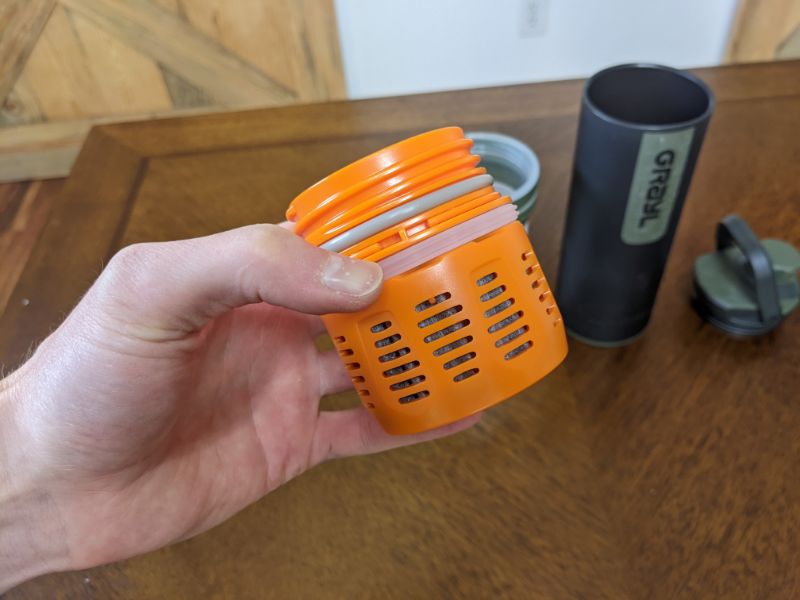
🔧Setup & Maintenance Considerations
In terms of ease of setup, the Grayl UltraPress was one of the best portable water purifiers I’ve used.
I didn’t have to prime or soak the filter before I could use it, and the actual assembly process was self-explanatory and took me a matter of minutes.
To assemble the bottle components, I:
- Inserted the purifier cartridge onto the bottom of the inner press
- Rotated the cartridge right until it clicked into the lock slot
And that was it! The bottle lid is already attached to the top of the inner press, so I could just slide the inner press into the bottle (this is easy to do when the bottle is empty) and stash it in my backpack, ready to use.
The biggest maintenance task required for the Grayl UltraPress is filter changes. Here’s where I was slightly let down – the filter only cleans up to 40 gallons of water before it will need to be replaced.
Unlike with many other portable water purifiers I’ve used, there’s no way to backwash the filter to open it up and extend its lifespan, either.
Additionally, using the UltraPress to filter dirty or sediment-rich water will further reduce its lifespan, meaning you’ll have to replace it more frequently. To prevent this, the manufacturer says you should pre-filter dirty or cloudy water in a t-shirt before filling the bottle, which will remove sediment and dirt. That means more forethought and more work.
There’s no filter change reminder, and no way to track the filter lifespan (unless I kept a log of my presses – the filter can be used for up to 300 presses).
Grayl says you should change the filter when the press time exceeds 25 seconds. The cost of a replacement purifier cartridge is around $30, so not too bad.
There were a few things I needed to do when storing the filter between uses:
- For short-term storage, Grayl advises drying the cartridge by performing 1-2 dry presses by pressing the wet cartridge into the bottle, then dumping the excess water, before letting the cartridge air-dry overnight.
- For long-term storage, I followed the same steps as above, but allowed 2-4 days for the cartridge to fully dry, then washed and dried the other components before reassembling the bottle to create an air-tight seal for storage.
After a filter has been used once, you can store it for up to 3 years as long as you follow Grayl’s recommended steps for storage.
Aside from filter changes, for the sake of good hygiene, I cleaned the UltraPress after every hike. This involved performing a dry press to get rid of any excess water. All the other parts of the bottle can be hand-washed with warm, soapy water.

🔨 Durability
Since I planned to use the Grayl UltraPress on my hiking and backpacking excursions, durability was a must for me. It needed to be able to withstand the occasional bump and bang, since it was going to get tossed around in my backpack quite a bit.
The UltraPress feels nice and sturdy, and according to Grayl, it can withstand impacts from drops up to 10 feet while full of water, onto hard surfaces like concrete (I didn’t personally test this theory!).
I used the bottle every day on my short hiking trips, which spanned 1-3 days on average. The bottle has been put through its paces, but I’ve only noticed a few marks and scratches – no dents or structural issues.
One thing I will say is that I wouldn’t recommend the UltraPress for long hikes and extended backpacking trips. It’s just too heavy, and when you’re backpacking, every single ounce of weight counts. Of course, that isn’t a matter of durability, but practicality.

🤔 Is the Grayl UltraPress Right for You?
In my opinion, the Grayl UltraPress UV water purifier is the best water purifier bottle for folks who want to be able to quickly and efficiently purify water for personal use, without the hassle of a straw filter, and with virtually no setup time.
It’s also a great fit for anyone who wants to improve the taste of their water as well as making it drinkable, and remove chemicals, heavy metals, and other particulates alongside microorganisms.
Because this purifier water bottle removes viruses, it’s suitable for international travel, and can be safely used in developing countries. The purification process targets a wide range of contaminants, so the Grayl water filter can be used to purify both tap water and natural water sources.
When don’t I recommend the Grayl UltraPress? Given the weight of the bottle, it wouldn’t be my first choice if I was looking for a filter to take on an extended backpacking trip.
Additionally, because of its limited 500ml water-holding capacity, it doesn’t provide the amount of water you need for drinking, cooking, cleaning dishes, hygiene, and so on, so it’s not good for camping in general, or emergency prep. And while it can be used to filter tap water supplies, if that’s your only use for a filtered water bottle, there are better alternatives for this purpose.
Found this review helpful?
Comment below or share this article!


Where are the components manufactured?
Great question, I had to reach out to their customer support. They confirmed their bottle components are manufactured in China.
How good is the filter to remove lead in the water ?
The powdered activated carbon media is capable of adsorbing heavy metals, including lead.
It’s amazing a legitimate place to purchase the Grayl?
Directly from the Grayl website here!